106. Cape Teal Anas capensis (Teeleend)
Order: Anseriformes. Family: Anatidae
Description
44-46 cm. The palest duck of the region. Pale and mainly grey plumage. Browner back. Has a speckled head and slightly upturned pink bill. In flight, speculum white with green centre.
Sexes are similar. Female is darker on head and whiter below.
Juveniles are paler duller brown above than adults and lack the pink on the bill.
Distribution
Found mostly in and around South Africa, where it is locally abundant in the Western Cape, North-West Province and Free State Province.
Habitat
Open area of fresh or salt water, mainly in salty, brackish vleis.
Diet
It feeds mainly on invertebrates and tadpoles, with about a quarter of its diet plant matter. It feeds by filtering on the surface, or with the head and neck submerged.
Breeding
Monogamous, solitary nester. The female builds the nest, which is a 10-16 cm wide bowl, 6 cm deep. It is usually made of aquatic plant leaves and stems, lined with down and contour feathers, usually placed on reed-filled islands. It lays 4-13 eggs, in successive mornings. Incubation is done solely by the female, for 26-30 days. The chicks, once dry, are immediately led by their mother to the water, as they know how to dive and swim by instinct. They remain with their mother for about 56 days, after which they start to become independent.
Call
Generally silent; male gives a high-pitched swee-tseeu, female utters a deep nasal querk.
Status
Common resident. In pairs or mixed flocks with nomadic and partial migrant populations.
Africa Wild Bird Book
- Flutterby
- Posts: 44029
- Joined: Sat May 19, 2012 12:28 pm
- Country: South Africa
- Location: Gauteng, South Africa
- Contact:
Cape Teal Photos
106. Cape Teal Anas capensis
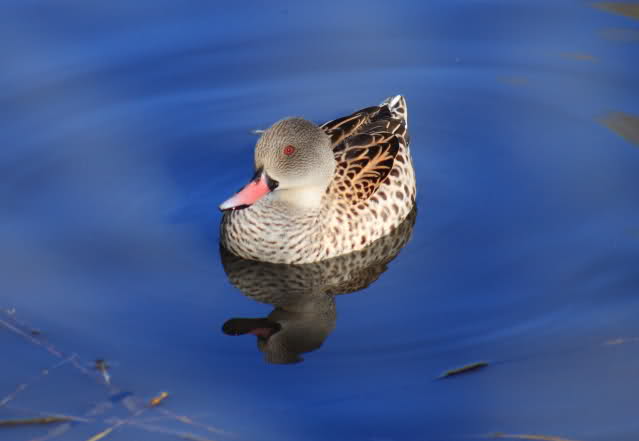 © Flutterby
© Flutterby
Bird Haven near Vereeniging
 © steamtrainfan
© steamtrainfan
Austin Roberts Memorial Bird Sanctuary
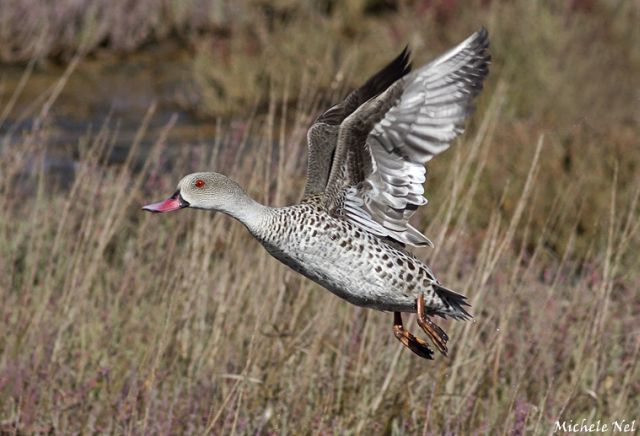 © Michele Nel
© Michele Nel
Links:
Species text Sabap1
Sabap2
Oiseaux net
 © Flutterby
© FlutterbyBird Haven near Vereeniging
 © steamtrainfan
© steamtrainfanAustin Roberts Memorial Bird Sanctuary
 © Michele Nel
© Michele NelLinks:
Species text Sabap1
Sabap2
Oiseaux net
- nan
- Posts: 26454
- Joined: Thu May 31, 2012 9:41 pm
- Country: Switzerland
- Location: Central Europe
- Contact:
Blue-billed Teal
107. Blue-billed Teal Spatula hottentota (Gevlekte Eend)
Order: Anseriformes. Family: Anatidae
English name changed from Hottentot Teal to Blue-billed Teal in concert with IOC and BirdLife South Africa List Committee, as the former name has become offensive.
Description
A diminutive species. Size 30-35 cm. Both sexes have blue-grey feet, black head, brown spotted breast, some green on their wings and a blue bill. The sexes are similar.
In flight, male has a green speculum with white secondaries, and a black and white underwing. Note the distinctive white trailing edge.
The female is much lighter on her underside. Female lacks the green speculum.
Juvenile is duller than adult. It has a brown-blue bill.
Similar species: Confusion with the Red-billed Teal is possible because of their black caps, but the blue (not red) bill, the dark smudge on its creamy cheeks, green speculum and generally more yellowish body plumage of the former are good field characters.
Distribution
Occurs from Ethiopia south, through southern DRC, Tanzania, Zambia and Angola to southern Africa. Within southern Africa it is locally common, occupying Namibia, northern and eastern Botswana, Zimbabwe, southern Mozambique and eastern South Afirica.
Habitat
It generally prefers permanent, shallow wetlands with bulrushes (Typha), reeds (Phragmites) or other tall, emergent vegetation. Mainly inland on small water bodies, often close to floating vegetation.
Movements
Thought to be a sedentary bird, rarely going on > 300 km journeys. The longest recorded flight is 694 km, although it can probably fly a lot further than that. It sometimes travels to the Okavango delta in the wet season.
Diet
This species is omnivorous and prefers smaller shallow bodies of water. The Blue-billed Teal feeds on seeds, roots, plants and insects that it finds in or near the water.
Breeding
Monogamous, territorial solitary nester. Interestingly, the pair bond barely lasts beyond incubation, with the male having almost no role in incubation and care of chicks. The female builds the nest, which is a deep bowl in the ground, filled with grass and leaves, often lined with down. It is usually placed in emergent vegetation near water. Laying dates vary with different regions, but usually in February-May. It lays 5-12 cream eggs, in successive days. Incubation is done solely by the female, for 25-27 days. She will sometimes leave the nest, to join the male in feeding and preening. The chicks are kept hidden in thick reedbeds, which makes them difficult to see. They fledge when they are about 60-65 days old.
Call
Soft quacks.
Status
Locally common resident but rare in the southwest of its range.
Order: Anseriformes. Family: Anatidae
English name changed from Hottentot Teal to Blue-billed Teal in concert with IOC and BirdLife South Africa List Committee, as the former name has become offensive.
Description
A diminutive species. Size 30-35 cm. Both sexes have blue-grey feet, black head, brown spotted breast, some green on their wings and a blue bill. The sexes are similar.
In flight, male has a green speculum with white secondaries, and a black and white underwing. Note the distinctive white trailing edge.
The female is much lighter on her underside. Female lacks the green speculum.
Juvenile is duller than adult. It has a brown-blue bill.
Similar species: Confusion with the Red-billed Teal is possible because of their black caps, but the blue (not red) bill, the dark smudge on its creamy cheeks, green speculum and generally more yellowish body plumage of the former are good field characters.
Distribution
Occurs from Ethiopia south, through southern DRC, Tanzania, Zambia and Angola to southern Africa. Within southern Africa it is locally common, occupying Namibia, northern and eastern Botswana, Zimbabwe, southern Mozambique and eastern South Afirica.
Habitat
It generally prefers permanent, shallow wetlands with bulrushes (Typha), reeds (Phragmites) or other tall, emergent vegetation. Mainly inland on small water bodies, often close to floating vegetation.
Movements
Thought to be a sedentary bird, rarely going on > 300 km journeys. The longest recorded flight is 694 km, although it can probably fly a lot further than that. It sometimes travels to the Okavango delta in the wet season.
Diet
This species is omnivorous and prefers smaller shallow bodies of water. The Blue-billed Teal feeds on seeds, roots, plants and insects that it finds in or near the water.
Breeding
Monogamous, territorial solitary nester. Interestingly, the pair bond barely lasts beyond incubation, with the male having almost no role in incubation and care of chicks. The female builds the nest, which is a deep bowl in the ground, filled with grass and leaves, often lined with down. It is usually placed in emergent vegetation near water. Laying dates vary with different regions, but usually in February-May. It lays 5-12 cream eggs, in successive days. Incubation is done solely by the female, for 25-27 days. She will sometimes leave the nest, to join the male in feeding and preening. The chicks are kept hidden in thick reedbeds, which makes them difficult to see. They fledge when they are about 60-65 days old.
Call
Soft quacks.
Status
Locally common resident but rare in the southwest of its range.
- nan
- Posts: 26454
- Joined: Thu May 31, 2012 9:41 pm
- Country: Switzerland
- Location: Central Europe
- Contact:
Hottentot Teal Photos
107. Hottentot Teal Anas hottentota

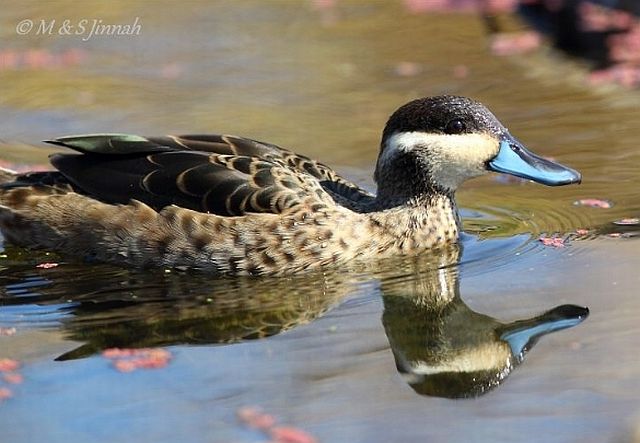 © Sharifa
© Sharifa
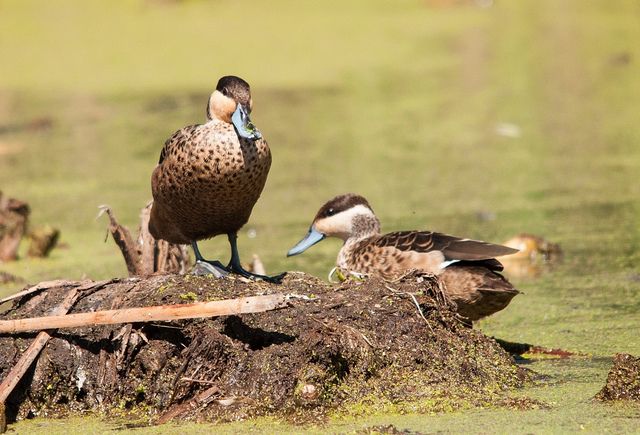 © steamtrainfan
© steamtrainfan
Marievale, Gauteng
Links:
http://sabap2.adu.org.za/docs/sabap1/107.pdf
http://sabap2.adu.org.za/spp_summary.ph ... §ion=3
Malcolm Alexander Ogilvie, Steve Young. Wildfowl of the World

 © Sharifa
© Sharifa © steamtrainfan
© steamtrainfanMarievale, Gauteng
Links:
http://sabap2.adu.org.za/docs/sabap1/107.pdf
http://sabap2.adu.org.za/spp_summary.ph ... §ion=3
Malcolm Alexander Ogilvie, Steve Young. Wildfowl of the World
Red-billed Teal
108. Red-billed Teal Anas erythrorhyncha (Rooibekeend)
Order: Anseriformes. Family: Anatidae
Description
It is a dabbling duck. 43–48 cm long. Only pink-billed duck in region with dark crown. Black cap and nape, pale face, and bright red bill. The body plumage is a dark brown edged with white. The secondary flight feathers are buff with a black stripe across them. The sexes are similar.
Juveniles are duller greyer and with less distinct scalingthan adults.
Distribution
Occurs from Ethiopia south, through southern DRC, Tanzania, Zambia and Angola to southern Africa. It is most abundant duck in South Africa, with a population of 500,000-1,000,000. It is also very common in Zimbabwe, northern Botswana and central Namibia.
Habitat
It generally prefers inland wetlands, which can be natural or artificial. It usually breeds in temporary pans and dams, with fringing emergent vegetation and grassland nearby.
Movements: Nomadic, rapidly locating new temporary pans and vleis. It rarely moves more than 250 km, although distances of 2190 km have been recorded. It usually leaves Botswana in the dry season, especially if Lake Ngami is dry. Flocks often move to temporary pans and vleis to breed.
Diet
It feeds mainly on seeds, with smaller quantities of animals. It usually forages in the early morning and early evening, normally by swimming with its head submerged, picking up food as it goes a long. It also up-ends dabbles and picks animals off vegetation.
Breeding
Monogamous, territorial solitary nester. The male is very protective of his territory, often fighting with other males and sometimes other species. Courtship is not particularly elaborate, with synchronised swimming, special calls and preening. The female builds the nest, which is a shallow depression in dry ground, filled with grass and leaves and sometimes lined with feathers. It is usually placed in thick vegetation, such as grass, reeds, stunted scrub, often 100-200m away from water. Laying dates vary, but they usually peak from November-May. It lays 5-16 eggs in successive mornings, usually before 09h00. Incubation is done solely by the female for 25-27 days. She normally takes two 1-2 hour breaks a day, covering the eggs with grass to join the male in preening, bathing and feeding. The chicks leave the nest for the water as soon as they are dry. They feed as a group, with the female protecting them from predators by pretending to be injured, so that the chicks can get under cover. The family group breaks up after about 3 weeks of being together, although the chicks are only capable of flight at 56 days old.
Call
The male has a whzzt or zee call, whereas the female has a soft quack.
Status
Very common resident, nomadic; in large flocks during non-breading season.
Order: Anseriformes. Family: Anatidae
Description
It is a dabbling duck. 43–48 cm long. Only pink-billed duck in region with dark crown. Black cap and nape, pale face, and bright red bill. The body plumage is a dark brown edged with white. The secondary flight feathers are buff with a black stripe across them. The sexes are similar.
Juveniles are duller greyer and with less distinct scalingthan adults.
Distribution
Occurs from Ethiopia south, through southern DRC, Tanzania, Zambia and Angola to southern Africa. It is most abundant duck in South Africa, with a population of 500,000-1,000,000. It is also very common in Zimbabwe, northern Botswana and central Namibia.
Habitat
It generally prefers inland wetlands, which can be natural or artificial. It usually breeds in temporary pans and dams, with fringing emergent vegetation and grassland nearby.
Movements: Nomadic, rapidly locating new temporary pans and vleis. It rarely moves more than 250 km, although distances of 2190 km have been recorded. It usually leaves Botswana in the dry season, especially if Lake Ngami is dry. Flocks often move to temporary pans and vleis to breed.
Diet
It feeds mainly on seeds, with smaller quantities of animals. It usually forages in the early morning and early evening, normally by swimming with its head submerged, picking up food as it goes a long. It also up-ends dabbles and picks animals off vegetation.
Breeding
Monogamous, territorial solitary nester. The male is very protective of his territory, often fighting with other males and sometimes other species. Courtship is not particularly elaborate, with synchronised swimming, special calls and preening. The female builds the nest, which is a shallow depression in dry ground, filled with grass and leaves and sometimes lined with feathers. It is usually placed in thick vegetation, such as grass, reeds, stunted scrub, often 100-200m away from water. Laying dates vary, but they usually peak from November-May. It lays 5-16 eggs in successive mornings, usually before 09h00. Incubation is done solely by the female for 25-27 days. She normally takes two 1-2 hour breaks a day, covering the eggs with grass to join the male in preening, bathing and feeding. The chicks leave the nest for the water as soon as they are dry. They feed as a group, with the female protecting them from predators by pretending to be injured, so that the chicks can get under cover. The family group breaks up after about 3 weeks of being together, although the chicks are only capable of flight at 56 days old.
Call
The male has a whzzt or zee call, whereas the female has a soft quack.
Status
Very common resident, nomadic; in large flocks during non-breading season.
Red-billed Teal Photos
108. Red-billed Teal Anas erythrorhyncha
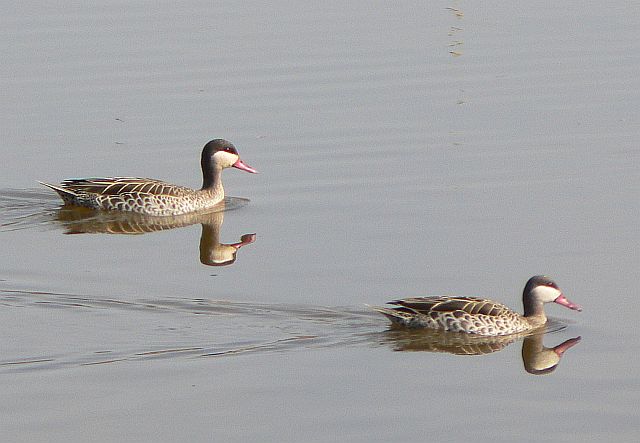 © Toko
© Toko
Mapungubwe National Park
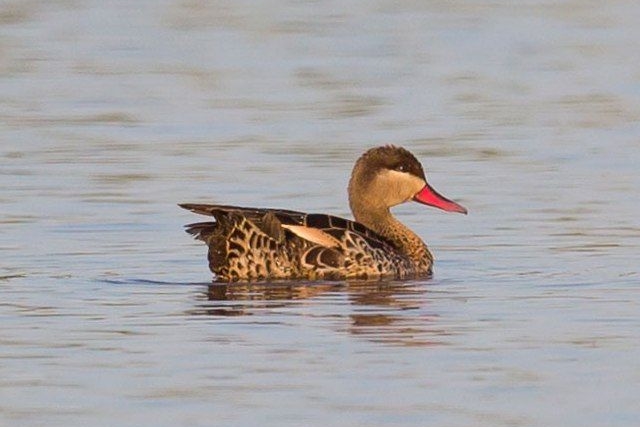 © Pumbaa
© Pumbaa
Kruger National Park
Links:
http://sabap2.adu.org.za/docs/sabap1/108.pdf
http://sabap2.adu.org.za/spp_summary.ph ... §ion=3
Oiseaux net
 © Toko
© TokoMapungubwe National Park
 © Pumbaa
© PumbaaKruger National Park
Links:
http://sabap2.adu.org.za/docs/sabap1/108.pdf
http://sabap2.adu.org.za/spp_summary.ph ... §ion=3
Oiseaux net
Northern Pintail
109. Northern Pintail Anas acuta (Pylsterteend)
Order: Anseriformes. Family: Anatidae
Description
Length: 50-65 cm. Wingspan: 80-95 cm. Male most likely to occur in non-breeding plumage, resembling the female.
The unmistakable breeding plumaged male has a chocolate-brown head and white breast with a white stripe extending up the side of the neck. Its upperparts and sides are grey, but elongated grey feathers with black central stripes are draped across the back from the shoulder area. The vent area is yellow, contrasting with the black underside of the tail, which has the central feathers elongated to as much as 10 cm. The bill is bluish and the legs are blue-grey.
The adult female is mainly scalloped and mottled in light brown with a more uniformly grey-brown head, and its pointed tail is shorter than the male's; it is still easily identified by its shape, long neck, and long grey bill. In non-breeding (eclipse) plumage, the drake Pintail looks similar to the female, but retains the male upperwing pattern and long grey shoulder feathers. Juvenile birds resemble the female, but are less neatly scalloped and have a duller brown speculum with a narrower trailing edge.
Distribution
Northern Hemishpere breeding bird. Breeds in North America and northern Eurasia, heading south in the non-breeding season to Africa, from Senegal to Sudan and Egypt south to Tanzania. It is a rare vagrant to southern Africa, with multiple records in Zimbabwe and one each in northern Botswana, Limpopo Province and North-West Province.
Habitat
It generally prefers shallow freshwater marshes, flood plains, small lakes, rivers and sewage ponds.
Diet
Both plant and animal foods, doing most of its foraging in the evening, by dabbling and up-ending in shallow water.
Breeding
Among the earliest nesting ducks, the northern pintail typical breeds from April to June. It nests in either solitary pairs or loose groups, and tends to construct its nest further away from water than most other duck species. The nest is a shallow scrape on the ground lined with plant material and down, in a dry location that may be fairly far from water, amongst dense vegetation or under a bush. Usually 7 to 9 eggs are laid, and are incubated for around 22 to 24 days.
Call
A mellow preop-proop by male and a descending series of quacks by female.
Listen to Bird Call.
Status
Vagrant to northern parts of the sub-region.
Order: Anseriformes. Family: Anatidae
Description
Length: 50-65 cm. Wingspan: 80-95 cm. Male most likely to occur in non-breeding plumage, resembling the female.
The unmistakable breeding plumaged male has a chocolate-brown head and white breast with a white stripe extending up the side of the neck. Its upperparts and sides are grey, but elongated grey feathers with black central stripes are draped across the back from the shoulder area. The vent area is yellow, contrasting with the black underside of the tail, which has the central feathers elongated to as much as 10 cm. The bill is bluish and the legs are blue-grey.
The adult female is mainly scalloped and mottled in light brown with a more uniformly grey-brown head, and its pointed tail is shorter than the male's; it is still easily identified by its shape, long neck, and long grey bill. In non-breeding (eclipse) plumage, the drake Pintail looks similar to the female, but retains the male upperwing pattern and long grey shoulder feathers. Juvenile birds resemble the female, but are less neatly scalloped and have a duller brown speculum with a narrower trailing edge.
Distribution
Northern Hemishpere breeding bird. Breeds in North America and northern Eurasia, heading south in the non-breeding season to Africa, from Senegal to Sudan and Egypt south to Tanzania. It is a rare vagrant to southern Africa, with multiple records in Zimbabwe and one each in northern Botswana, Limpopo Province and North-West Province.
Habitat
It generally prefers shallow freshwater marshes, flood plains, small lakes, rivers and sewage ponds.
Diet
Both plant and animal foods, doing most of its foraging in the evening, by dabbling and up-ending in shallow water.
Breeding
Among the earliest nesting ducks, the northern pintail typical breeds from April to June. It nests in either solitary pairs or loose groups, and tends to construct its nest further away from water than most other duck species. The nest is a shallow scrape on the ground lined with plant material and down, in a dry location that may be fairly far from water, amongst dense vegetation or under a bush. Usually 7 to 9 eggs are laid, and are incubated for around 22 to 24 days.
Call
A mellow preop-proop by male and a descending series of quacks by female.
Listen to Bird Call.
Status
Vagrant to northern parts of the sub-region.
Garganey
110. Garganey Anas querquedula (Somereend)
Order: Anseriformes. Family: Anatidae

Description
Garganeys are quite small ducks (37-41 cm).
The male in breeding plumage has brown head with a prominent, white supercilium, brown breast and white underparts. The body is heavily spotted at front and rear with pale flanks and long black, blue and white striped scapulars with striking white eyestripe, blue-grey flanks.
The eclipse male resembles the female.
Females are greyish overall with broadly pale-edged dark flanks. Parallel headstripes.The broad pale supercilium over a bold dark eye stripe is a good id feature.
The speculum is green with white lines along the front and rear edges. The underwing pattern is prominent black and white.
Distribution
Western Palearctic. Breeds in a broad band between 40-65° North from western Europe to the Pacific, heading south in the non-breeding season to South-East Asia and sub-Saharan Africa. Within southern Africa it is generally rare in central Zimbabwe and north-eastern Namibia, while it is a rare vagrant to southern Botswana and South Africa.
Habitat: It generally prefers shallow freshwater wetlands with emergent vegetation, such as flood plains, shallow dams, pans and sewage ponds.
Movements and migrations
Mainly present in southern Africa in the period from November-April.
Diet
Animal and plant material. It mainly eats aquatic insects and their larvae, such as molluscs, crustaceans, worms and leeches, as well as frog spawn, tadpoles and fish. It does most of its foraging by swimming with its head underwater.
Breeding
Starts breeding after arrival in breeding area in April and May. The nest is usually near water on ground, lined with down and feathers. Lays 8-9 eggs.
Call
Generally silent in region. Listen to Bird Call.
Status
Rare vagrant in summer.
Order: Anseriformes. Family: Anatidae

Description
Garganeys are quite small ducks (37-41 cm).
The male in breeding plumage has brown head with a prominent, white supercilium, brown breast and white underparts. The body is heavily spotted at front and rear with pale flanks and long black, blue and white striped scapulars with striking white eyestripe, blue-grey flanks.
The eclipse male resembles the female.
Females are greyish overall with broadly pale-edged dark flanks. Parallel headstripes.The broad pale supercilium over a bold dark eye stripe is a good id feature.
The speculum is green with white lines along the front and rear edges. The underwing pattern is prominent black and white.
Distribution
Western Palearctic. Breeds in a broad band between 40-65° North from western Europe to the Pacific, heading south in the non-breeding season to South-East Asia and sub-Saharan Africa. Within southern Africa it is generally rare in central Zimbabwe and north-eastern Namibia, while it is a rare vagrant to southern Botswana and South Africa.
Habitat: It generally prefers shallow freshwater wetlands with emergent vegetation, such as flood plains, shallow dams, pans and sewage ponds.
Movements and migrations
Mainly present in southern Africa in the period from November-April.
Diet
Animal and plant material. It mainly eats aquatic insects and their larvae, such as molluscs, crustaceans, worms and leeches, as well as frog spawn, tadpoles and fish. It does most of its foraging by swimming with its head underwater.
Breeding
Starts breeding after arrival in breeding area in April and May. The nest is usually near water on ground, lined with down and feathers. Lays 8-9 eggs.
Call
Generally silent in region. Listen to Bird Call.
Status
Rare vagrant in summer.



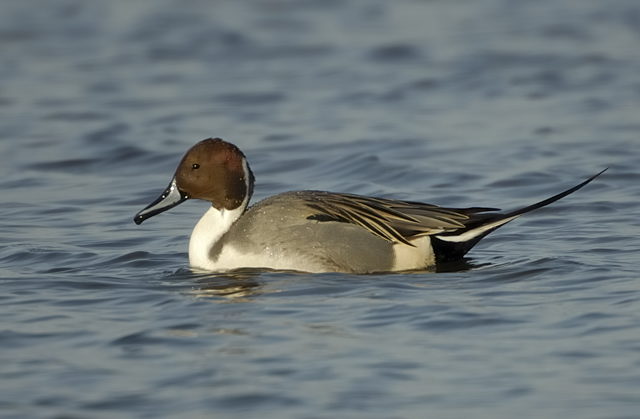
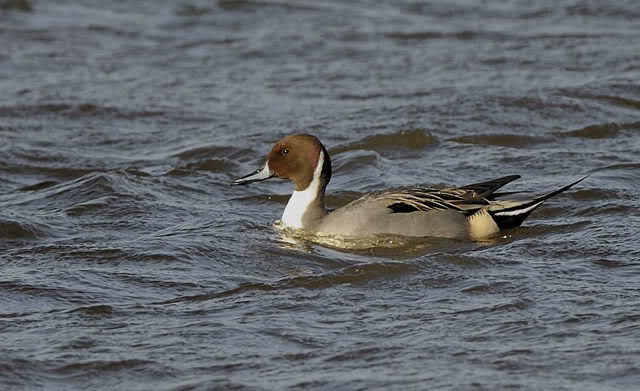
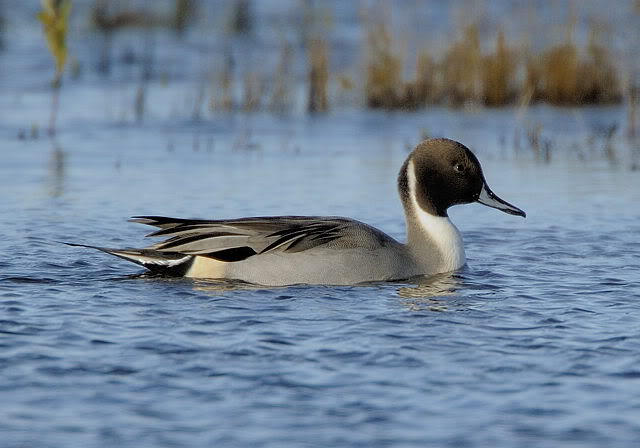
 © nan
© nan